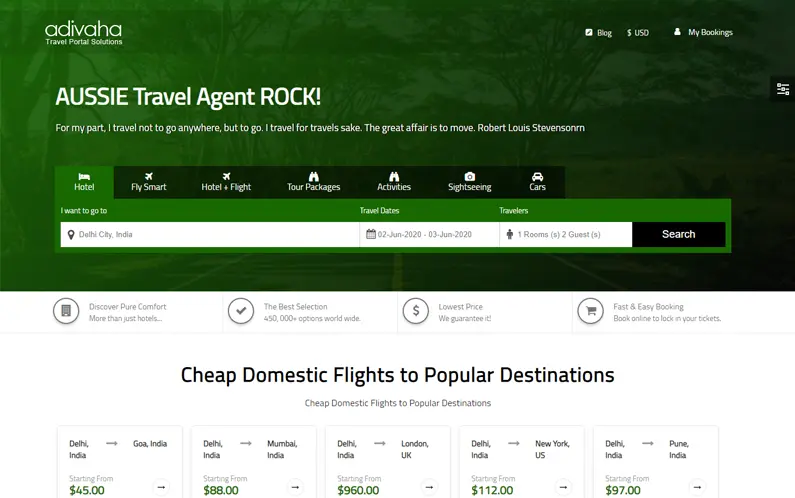Ready to go-LIVE travel solutions that helps your travel agency to sell a range of travel services pretty instantly. adivaha® travel solutions make sure you have no boundation over your imagination, you can do everything online, without the need for any technical knowledge or design skills. Easy Backoffice, extensive reporting with integrated Funds Management System.
Integrate Travel API - Unlock Seamless Booking Experiences
Travel XML API integration has revolutionized the way travel portals access and display real-time data. By integrating the travel XML API, portals can offer a seamless booking experience to their users. The process of travel XML integration involves connecting the portal's systems with the XML data provided by various airlines, hotels, and other service providers. One key aspect of travel XML API integration is ensuring that the data is updated regularly. This ensures that users always have access to the latest information when booking flights or accommodations on the portal.
XML-based hotels and flights API travel portals are becoming increasingly popular due to the ease and convenience they offer to travelers. By integrating XML APIs for hotels and flights, travel portals can provide users with a wide range of options to choose from. The XML-based hotels and flights API travel portals allow users to compare prices, check availability, and make reservations in real-time. This level of flexibility and interactivity enhances the overall user experience, making it easier for travelers to find the best deals and plan their trips efficiently.
The integration of travel XML APIs offers numerous benefits to both travel portals and users. Travel portals that integrate XML APIs can access a vast amount of data from multiple service providers, giving users a comprehensive view of their travel options. By utilizing XML-based hotels and flights API travel portals, users can enjoy a streamlined booking process that saves time and effort. Additionally, the real-time updates provided by XML APIs ensure that users have access to accurate and up-to-date information, enabling them to make well-informed decisions when planning their travel itineraries.
Adivaha Travel Technology is a leading player in the travel technology industry, offering innovative solutions to help businesses thrive in the digital age. As one of the best travel technology companies, Adivaha stands out for its cutting-edge software and tools that empower travel agencies to streamline operations, increase efficiency, and boost revenue. By leveraging Adivaha's advanced technology solutions, travel businesses can stay ahead of the competition and provide a seamless booking experience for their customers. With a focus on user-friendly interfaces and customizable features, Adivaha Travel Technology is trusted by top travel agencies worldwide.
When it comes to finding the best travel technology company to partner with, Adivaha Travel Technology is a top choice for businesses looking to enhance their online presence and drive growth. With a range of customizable solutions designed to meet the unique needs of travel agencies, Adivaha offers software that is both powerful and easy to use. By integrating Adivaha's technology into their operations, travel businesses can tap into new markets, increase bookings, and improve customer satisfaction. As one of the top 10 travel technology companies in the industry, Adivaha is committed to delivering cutting-edge solutions that help businesses succeed in a competitive market.
As one of the top 10 travel technology companies globally, Adivaha Travel Technology continues to revolutionize the way travel agencies operate in an increasingly digital world. With a focus on innovation and customer satisfaction, Adivaha offers a suite of software solutions that empower travel businesses to thrive in a competitive market. By choosing Adivaha as their technology partner, businesses can leverage state-of-the-art tools and features to streamline operations, drive revenue, and deliver exceptional customer experiences. With its reputation as one of the best travel technology companies in the industry, Adivaha Travel Technology sets the standard for excellence in travel technology solutions.
When looking for the best travel technology company to enhance your travel business, Adivaha Travel Technology stands out as a top choice. Their innovative solutions help travel agencies integrate travel APIs seamlessly, unlocking opportunities for a superior booking experience. Adivaha Travel Technology prides itself on being one of the top 10 travel technology companies globally, offering cutting-edge tools that streamline the booking process and elevate customer satisfaction.
With Adivaha Travel Technology as your partner, you can harness the power of their travel APIs to create a more efficient and user-friendly booking system. By integrating their solutions, you can provide your customers with a seamless booking experience that sets your business apart. As one of the best travel technology companies in the industry, Adivaha Travel Technology is committed to helping travel agencies succeed in a competitive market. Their expertise and dedication to innovation make them a valuable partner for businesses looking to improve their online booking capabilities.
Adivaha Travel Technology's reputation as a top 10 travel technology company is well-deserved, given their track record of delivering state-of-the-art solutions for the travel industry. By leveraging their expertise in travel APIs, you can enhance your booking platform and offer customers a streamlined, intuitive booking process. With Adivaha Travel Technology, you can integrate travel APIs seamlessly and unlock new opportunities for growth and success in the ever-evolving travel industry.
Keep Refreshing your customers - Who doesn't want his site to stand out from crowd? adivaha® gives you multiple options for home pages, headers, colors etc. Which can easily be managed from admin via shortcodes and settings. The theme supports almost all the big players in this market ie, WEGO, Travelpayouts, Agoda, Booking, Expedia etc.












